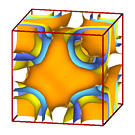|
|
Amphiphilic self-assembly
|
||||||||
| Inverse cubic bicontinuous phases in lipid-water systems: the mid-surface of the lipid bilayer is a triply periodic minimal surface (blue). The two parallel surfaces are the neutral surfaces of the lipid monolayers (orange). |
Amphiphiles like tensids or lipids are small molecules which have both hydrophilic and hydrophobic parts and self-assemble in polar solvents like water, non-polar solvents like oil or at the interfaces of polar and non-polar regions of space. Since the presence of amphipiles reduces the surface tension between e.g. water and oil by several orders of magnitude, tensides are widely used for all kinds of washing and emulsification purposes. Self-assembly of lipid molecules is used in biological systems to provide spatial coordination by extended systems of lipid bilayers; this includes the plasma membrane, the endoplasmic reticulum, the Golgi apparatus and the densely folded membranes in mitochondria.
Amphiphilic systems exhibit, in general, an amazing degree of polymorphism due to the very small differences in free energy between the various structures possible. This means that structural changes can occur not only as a function of temperature, but also as the composition of the system is varied. Disordered as well as ordered phases can form. In binary systems of amphiphile and water, the basic building blocks are spherical micelles, cylindrical micelles and bilayers. Here the disordered phases include the disordered micellar phase and the sponge phase consisting of an irregular array of bilayers. The ordered phases include the lamellar phase, the hexagonal phase, the micellar cubic phase and the bicontinuous cubic phase. Typical tensides have one hydrocarbon chain and a head group area which is larger, thus they tend to form micellar phases. In contrast, typical lipids have two hydrocarbon chains, their headgroup and tail areas are often of similar size, thus they tend to form lamellar phases. This is used in biological systems in which lipid bilayers form the cell's different compartments. It is a long-standing puzzle that biological bilayers are composed of a mixture of different lipids, some of which form non-lamellar (hexagonal) phases by themselves. Such a situation in fact favors bicontinuous cubic phases, which unit the structural elements of lamellar and hexagonal phases. Recently it has been shown that bicontinuous cubic structures are ubiquitous in biological systems.
In ternary systems of amphiphile, water and oil, the same phases exist as in the binary systems, only that now the hydrophobic regions are filled with oil. As basic building blocks now only amphiphilic monolayers at the oil-water interface occur. For example, if one replaces the bilayers of the binary sponge phase with monolayers, and the water regions facing now the hydrophobic side with oil regions, one gets a ternary microemulsion. A microemulsion is a thermodynamically stable and homogeneous phase which allows to mix oil and water in similar amounts just by adding (at the right temperature) some suitable amphiphile. One industrial application for the microemulsion is tertiary oil recovery.
Since typical energies are of the order of kT, the theoretical description of amphiphilic systems in equilibrium centers around the roles of geometrical structure and thermal fluctuations. Much progress has been made by using models which start from effective properties of amphiphilic systems on mesoscopic length scales. I used both Ginzburg-Landau theories and curvature models in order to explain generic aspects of non-ionic amphiphilic phase behavior. To learn more on these subjects, click here for an introduction to bicontinuous phases or here for my own work on bicontinuous cubic phases based on triply periodic minimal surfaces.
Publications:
- U. S. Schwarz and G. Gompper, Bicontinuous surfaces in self-assembling amphiphilic systems, In: Morphology of Condensed Matter: Physics and Geometry of Spatially Complex Systems, Eds. K. R. Mecke and D. Stoyan, Springer Lecture Notes in Physics Vol. 600, pp. 107-151, 2002 (abstract, cond-mat/0301325, PDF, the complete volume at Springer)
- U. S. Schwarz and G. Gompper, Bending frustration of lipid-water mesophases based on cubic minimal surfaces, Langmuir 17: 2084 -2096 (2001) (abstract, cond-mat/0102466, PDF)
- U. S. Schwarz and G. Gompper, Stability of inverse bicontinuous cubic phases in lipid-water mixtures, Phys. Rev. Lett. 85: 1472-1475 (2000) (abstract, cond-mat/0009025, PDF)
- U. S. Schwarz and G. Gompper, Stability of bicontinuous cubic phases in ternary amphiphilic systems with spontaneous curvature, J. Chem. Phys. 112: 3792 - 3802 (2000) (abstract, cond-mat/9911252, PDF)
- U. S. Schwarz and G. Gompper, A systematic approach to bicontinuous cubic phases in ternary amphiphilic systems, Phys. Rev. E 59: 5528 - 5541 (1999) (abstract, cond-mat/9903406, PDF)
- U. S. Schwarz, Phase behavior of amphiphilic systems, Acta Phys. Pol. B 29: 1815-1825 (1998) (abstract, PDF)
- U. S. Schwarz and K. Swamy and G. Gompper, The lamellar-to-isotropic transition in ternary amphiphilic systems, Europhys. Lett. 36: 117-122 (1996) (abstract, cond-mat/9608157, PDF)
- G. Gompper and U. S. Schwarz, Phase diagram and scattering intensity of binary amphiphilic systems, Z. Phys. B 97: 233-238 (1995) (abstract, PDF)
Last modified Tue Jan 7 10:19:24 CET 2003.
Back to home page Ulrich Schwarz.





